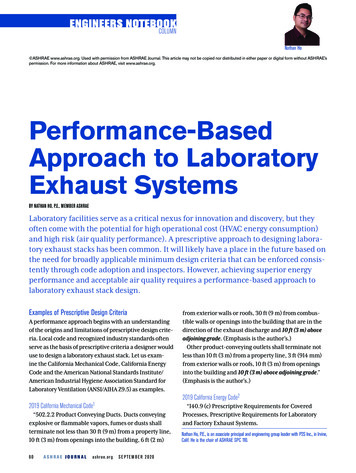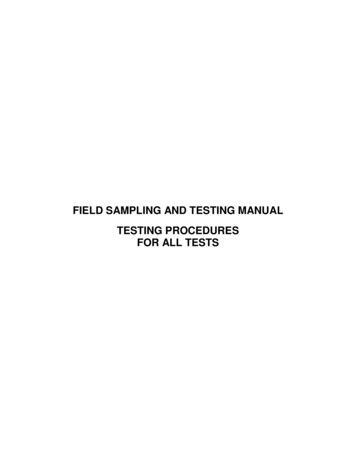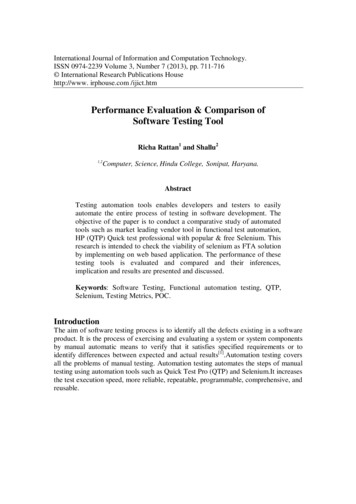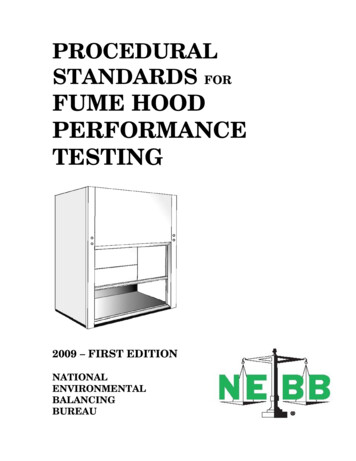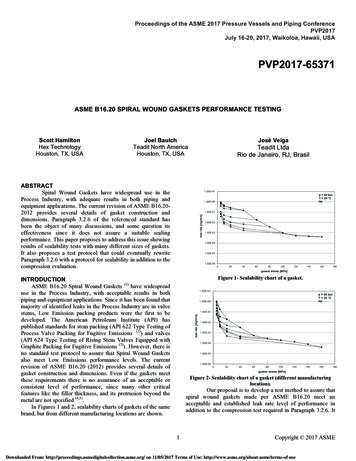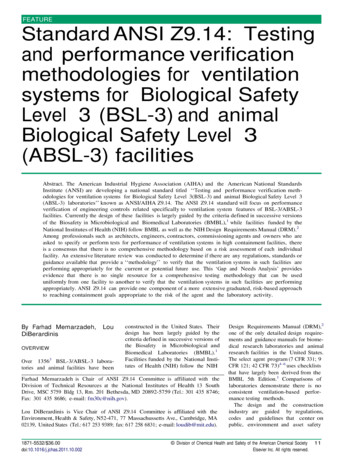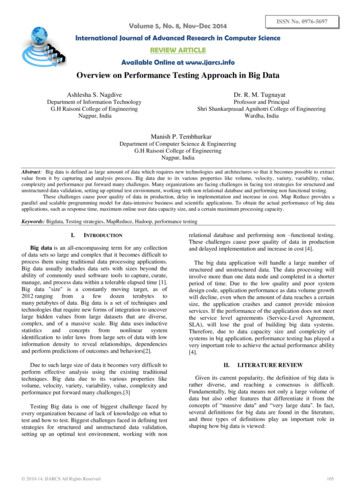
Transcription
ISSN No. 0976-5697Volume 5, No. 8, Nov-Dec 2014International Journal of Advanced Research in Computer ScienceREVIEW ARTICLEAvailable Online at www.ijarcs.infoOverview on Performance Testing Approach in Big DataAshlesha S. NagdiveDr. R. M. TugnayatDepartment of Information TechnologyG.H Raisoni College of EngineeringNagpur, IndiaProfessor and PrincipalShri Shankarprasad Agnihotri College of EngineeringWardha, IndiaManish P. TembhurkarDepartment of Computer Science & EngineeringG.H Raisoni College of EngineeringNagpur, IndiaAbstract: Big data is defined as large amount of data which requires new technologies and architectures so that it becomes possible to extractvalue from it by capturing and analysis process. Big data due to its various properties like volume, velocity, variety, variability, value,complexity and performance put forward many challenges. Many organizations are facing challenges in facing test strategies for structured andunstructured data validation, setting up optimal test environment, working with non relational database and performing non functional testing.These challenges cause poor quality of data in production, delay in implementation and increase in cost. Map Reduce provides aparallel and scalable programming model for data-intensive business and scientific applications. To obtain the actual performance of big dataapplications, such as response time, maximum online user data capacity size, and a certain maximum processing capacity.Keywords: Bigdata, Testing strategies, MapReduce, Hadoop, performance testingI.INTRODUCTIONBig data is an all-encompassing term for any collectionof data sets so large and complex that it becomes difficult toprocess them using traditional data processing applications.Big data usually includes data sets with sizes beyond theability of commonly used software tools to capture, curate,manage, and process data within a tolerable elapsed time [1].Big data "size" is a constantly moving target, as of2012 ranging from a few dozen terabytes tomany petabytes of data. Big data is a set of techniques andtechnologies that require new forms of integration to uncoverlarge hidden values from large datasets that are diverse,complex, and of a massive scale. Big data uses inductivestatisticsand concepts fromnonlinear systemidentification to infer laws from large sets of data with lowinformation density to reveal relationships, dependenciesand perform predictions of outcomes and behaviors[2].Due to such large size of data it becomes very difficult toperform effective analysis using the existing traditionaltechniques. Big data due to its various properties likevolume, velocity, variety, variability, value, complexity andperformance put forward many challenges.[3]Testing Big data is one of biggest challenge faced byevery organization because of lack of knowledge on what totest and how to test. Biggest challenges faced in defining teststrategies for structured and unstructured data validation,setting up an optimal test environment, working with non 2010-14, IJARCS All Rights Reservedrelational database and performing non –functional testing.These challenges cause poor quality of data in productionand delayed implementation and increase in cost [4].The big data application will handle a large number ofstructured and unstructured data. The data processing willinvolve more than one data node and completed in a shorterperiod of time. Due to the low quality and poor systemdesign code, application performance as data volume growthwill decline, even when the amount of data reaches a certainsize, the application crashes and cannot provide missionservices. If the performance of the application does not meetthe service level agreements (Service-Level Agreement,SLA), will lose the goal of building big data systems.Therefore, due to data capacity size and complexity ofsystems in big application, performance testing has played avery important role to achieve the actual performance ability[4].II.LITERATURE REVIEWGiven its current popularity, the definition of big data israther diverse, and reaching a consensus is difficult.Fundamentally, big data means not only a large volume ofdata but also other features that differentiate it from theconcepts of “massive data'' and “very large data''. In fact,several definitions for big data are found in the literature,and three types of definitions play an important role inshaping how big data is viewed:165
Ashlesha S. Nagdive et al, International Journal of Advanced Research in Computer Science, 5 (8), Nov–Dec, 2014,165-169Figure 1: Growth of and Digitization of Global Information Storage Capacity [12]A. Attributive Definition:IDC is a pioneer in studying big data and its impact. Itdefines big data in a 2011 report that was sponsored byEMC (the cloud computing leader) : “Big data technologiesdescribe a new generation of technologies and architectures,designed to economically extract value from very largevolumes of a wide variety of data, by enabling high-velocitycapture, discovery, and/or analysis.'' This definitiondelineates the four salient features of big data, i.e., volume,variety, velocity and value. As a result, the 4Vs'' definitionhas been used widely to characterize big data. A similardescription appeared in a 2001 research report in whichMETA group (now Gartner) analyst Doug Laney noted thatdata growth challenges and opportunities are threedimensional, i.e., increasing volume, velocity, and variety.Although this description was not meant originally to definebig data, Gartner and much of the industry, including IBMand certain Microsoft researchers, continue to use this 3Vs'' model to describe big data 10 years later [5].sectors) of what a dataset must be to be considered as bigdata.B. Comparative Definition:In 2011, Mckinsey's report defined big data as “datasetswhose size is beyond the ability of typical database softwaretools to capture, store, manage, and analyze.” This definitionis subjective and does not define big data in terms of anyparticular metric [6]. However, it incorporates anevolutionary aspect in the definition (over time or acrossDifferent testing types like functional and non functionaltesting are required along with strong test data and testenvironment management to ensure that the data from variedsources is processed error free and can obtained good qualityto perform analysis. Functional testing activities likevalidation of map reduce process, structured and unstructured 2010-14, IJARCS All Rights ReservedC. Architectural Definition:The National Institute of Standards and Technology(NIST) suggests that, “Big data is where the data volume,acquisition velocity, or data representation limits the abilityto perform effective analysis using traditional relationalapproaches or requires the use of significant horizontalscaling for efficient processing” In particular, big data canbe further categorized into big data science and big dataframeworks. Big data science is “the study of techniquescovering the acquisition, conditioning, and evaluation of bigdata,” whereas big data frameworks are “software librariesalong with their associated algorithms that enable distributedprocessing and analysis of big data problems across clustersof computer units”. An instantiation of one or more big dataframeworks is known as big data infrastructure [5].III.TESTING STRATEGIES166
Ashlesha S. Nagdive et al, International Journal of Advanced Research in Computer Science, 5 (8), Nov–Dec, 2014,data validation, data storage validation are important toensure the data is correct and is of good quality[3].Figure 2: Big data architecture [3]Hadoop is a framework that allows for distributedprocessing of large data sets across clusters of computer.Hadoop uses Map/reduce, where the application is divided intomany small fragments of work, which may be executed on anynode in the cluster [3]. The process is illustrated below by anexample based on the open source Apache Hadoop softwareframework:Loading the initial data into the HadoopDistributed File System (HDFS).Execution of Map-Reduce operations.Rolling out the output results from the HDFS.Figure 3: Process Flowchart of Big data FrameworkA. Loading the initial data into the Hadoop Distributed FileSystem (HDFS).B. Execution of Map-Reduce operations.A. Loading the Initial Data into HDFSIn this first step, the data is retrieved from various sources(social media, web logs, social networks etc.) and uploadedinto the HDFS, being split into multiple files:Verify that the required data was extracted from theoriginal system and there was no data corruption [4].Validate that the data files were loaded into theHDFS correctly [4].Check the files partition and copy them to differentdata units [4].Determine the most complete set of data that needs tobe checked [4].B. Execution of Map-Reduce Operations[4]In this step, you process the initial data using a MapReduce operation to obtain the desired result. Map-reduce is adata processing concept for condensing large volumes of datainto useful aggregated results:Check required business logic on standalone unit andthen on the set of units.Validate the Map-Reduce process to ensure that the“key-value” pair is generated correctly.Check the aggregation and consolidation of data afterperforming "reduce" operation.C. Rolling out the output results from the HDFS. 2010-14, IJARCS All Rights Reserved167
Ashlesha S. Nagdive et al, International Journal of Advanced Research in Computer Science, 5 (8), Nov–Dec, 2014,Compare the output data with initial files to makesure that the output file was generated and its formatmeets all the requirements.C. Rolling out the Output Results from HDFS:This final step includes unloading the data that wasgenerated by the second step and loading it into thedownstream system, which may be a repository for data togenerate reports or a transactional analysis system for furtherprocessing: Conduct inspection of data aggregation to makesure that the data has been loaded into the required system andthus was not distorted. Validate that the reports include all therequired data and all indicators are referred to concretemeasures and displayed correctly [4].As speed is one of Big Data’s main characteristics, it ismandatory to do performance testing. A huge volume of dataand an infrastructure similar to the production infrastructure isusually created for performance testing. Furthermore, if this isacceptable, data is copied directly from production. Todetermine the performance metrics and to detect errors, youcan use, for instance, the Hadoop performance monitoringtool. There are fixed indicators like operating time, capacityand system-level metrics like memory usage withinperformance testing[4].To be successful, Big Data testers haveto learn the components of the Big Data ecosystem fromscratch. Since the market has created fully automated testingtools for Big Data validation, the tester has no other option butto acquire the same skill set as the Big Data developer in thecontext of leveraging the Big Data technologies like Hadoop.This requires a tremendous mindset shift for both the testers aswell as testing units within organizations. In order to becompetitive, companies should invest in Big Data-specifictraining needs and developing the automation solutions for BigData validation [4].IV.TOOLS AND TECHNIQUES AVAILABLEA. Hadoop:Hadoop is an open source project hosted by ApacheSoftware Foundation, a framework for distributedstorage and distributed processing of Big Data on clusters ofcommodity hardware. Its Hadoop Distributed File System(HDFS) splits files into large blocks (default 64MB or128MB) and distributes the blocks amongst the nodes in thecluster[5].Forprocessingthedata,theHadoop Map/Reduce ships code to the nodes that have therequired data and the nodes then process the data in parallel.This approach takes advantage of data locality, in contrast toconventional HPC architecture which usually relies ona parallel file system. It consists of many small sub projectswhich belong to the category of infrastructure for distributedcomputing. Hadoop mainly consists of [5]:File System (The Hadoop File System)Programming Paradigm (Map Reduce)There are various problems in dealing with storage oflarge amount of data. Though the storage capacities of thedrives have increased massively but the rate of reading datafrom them hasn’t shown that considerable improvement. Thereoccur many problems also with using many pieces of hardwareas it increases the chances of failure. This can be avoided by 2010-14, IJARCS All Rights ReservedReplication i.e. creating redundant copies of the same data atdifferent devices so that in case of failure the copy of the datais available. The main problem is of combining the data beingread from different devices. Many a methods are available indistributed computing to handle this problem but still it isquite challenging. Such problems are easily handled byHadoop [5]. The problem of failure is handled by the HadoopDistributed File System and problem of combining data ishandled by Map reduce programming Paradigm. Map Reducereduces the problem of disk reads and writes by providing aprogramming model dealing in computation with keys andvalues. Hadoop thus provides: a reliable shared storage and ananalysis system. The storage is provided by HDFS andanalysis by MapReduce.B. MapReduce:MapReduce is the programming paradigm allowing massivescalability. The MapReduce basically performs two differenttasks i.e. Map Task and Reduce Task [5]. A map-reducecomputation executes as follows: Map tasks are given inputfrom distributed file system. The map tasks produce asequence of key-value pairs from the input and this is doneaccording to the code written for map function. These valuegenerated are collected by master controller and are sorted bykey and divided among reduce tasks [5][6]. The sortingbasically assures that the same key values ends with the samereduce tasks. The Reduce tasks combine all the valuesassociated with a key working with one key at a time. Againthe combination process depends on the code written forreduce job. The Master controller process and some number ofworker processes at different compute nodes are forked by theuser. The Master controller creates some number of maps andreduces tasks which are usually decided by the user program.The tasks are assigned to the worker nodes by the mastercontroller. Track of the status of each Map and Reduce task iskept by the Master Process. The failure of a compute node isdetected by the master as it periodically pings the workernodes. All the Map tasks assigned to that node are restartedeven if it had completed and this is due to the fact that theresults of that computation would be available on that nodeonly for the reduce tasks. The status of each of these Maptasks is set to idle by Master. These get scheduled by Masteron a Worker only when one becomes available. The Mastermust also inform each Reduce task that the location of its inputfrom that Map task has changed [5].V.NON FUNCTIONAL TESTINGA. Performance TestingBig data applications through performance testing, we canachieve the following objectives1) Obtain the actual performance of big dataapplications, such as response time, maximum onlineuser data capacity size, and a certain maximumprocessing capacity.2) Access performance limits and found that theconditions can cause performance problems, such astesting under load is applied to some problems canoccur after a long run in big data application.3) Achieve performance status and resource status in bigdata application, and to optimize the performanceparameters in big data applications (eg. hardware168
Ashlesha S. Nagdive et al, International Journal of Advanced Research in Computer Science, 5 (8), Nov–Dec, 2014,configuration,parameterapplication-level code).configurationandThe purposes of performance testing are not onlyacknowledging application performance levels to, but toimprove the performance of the big data application. Beforeperformance testing, test engineers should fully consider theirtesting requirement and then design a complete test scenario toconsider the test program with the actual situation of the useroperation [10]. Through the test execution and results analysis,performance bottlenecks can be found and analysis the reasonfurther. In the performance test, test engineers need to collectthe resource use information during performance testexecution. Related to response time, the collecting resourcesuse information, the more obtained performance informationanalysis, and the more analysis of system performancebottleneck[11].Not only for big data application infrastructure,data processing capabilities, network transmission capacity indepth testing, but also from the basic characteristics of big datato analyze the factors affecting the performance of big dataapplications. In big data applications, the rapid growth ofmobile computing and network users, mobile devices,changing only the type of data occurs, and the data generatedis very rapid with increase of real-time data transactions [11].If the performance does not meet SLA, the purpose ofsetting up Hadoop and other big data technologies fails. Hencethe performance testing plays vital role in big data project.B. FailoverTesting:Hadoop architecture consists of node and hundreds of datanodes hosted on server machine .There are chances of nodefailure and HDFS components become non functional. HDFSarchitecture is designed to detect these failures andautomatically recover to proceed with the processing. Failovertesting validates the recovery process and ensures the dataprocessing when switched to other data nodes. Recovery TimeObjective (RTO) and Recovery Point Objective (RPO) metricsare captured during failover testing.VI.CONCLUSIONThis paper described the overview of problems faced by Bigdata storage and inconsistency. The challenge faced today ishow to test big data and improving the performance of the bigdata application [6]. Hadoop tool for Big data is described indetail. Map Reduce provides a parallel and scalableprogramming model for data-intensive business and scientificapplications [7]. Various testing strategies are studied required 2010-14, IJARCS All Rights Reservedfor big data. We propose a performance diagnosticmethodology that integrates statistical analysis from differentlayers, and design a heuristic performance diagnostic toolwhich evaluates the validity and correctness of Hadoop byanalyzing the job traces of popular big data benchmarks[8][9].We can obtain the actual performance of big data applications,such as response time, maximum online user data capacitysize, and a certain maximum processing capacity. Thetechnology provided test goal analysis, test design, load designfor big data application [10], [11].VII. REFERENCES[1]Zhenyu Liu, “Research of Performance Test Technology for Big DataApplications”, in IEEE International Conference on Information andAutomation Hailar, China, July 2014.[2]Jie Li,, Zheng Xu, , Yayun Jiang and Rui Zhang, “The Overview of BigData Storage and Management”, Proc. 2014 IEEE 13th Int’l Conf. onCognitive Informatics & Cognitive Computing (ICCI’CC’14), 2014.[3]Roberto Paulo Andrioli de Araujo, Marcos Lordello Chaim, “Data-flowTesting in the Large” , IEEE International Conference on SoftwareTesting, Verification, and Validation 2014.[4]Mahesh Gudipati,Shanthi Rao, Naju D. Mohan and Naveen KumarGajja, “Big Data: Testing Approach to Overcome QualityChallenges”,Infosys labsBriefingVol 11, NO 1, 2013.[5]Avita Katal, Mohammad Wazid, R H Goudar, “Big Data: Issues,Challenges, Tools and Good Practices”, IEEE, 2013.[6]Xiaoming Gao, Judy Qiu, “Supporting Queries and Analyses of LargeScale Social Media Data with Customizable and Scalable IndexingTechniques over NoSQL Databases”, 14th IEEE/ACM InternationalSymposium on Cluster, Cloud and Grid Computing, 2014.[7]Rongxing Lu, Hui Zhu, Ximeng Liu, Joseph K. Liu
Keywords: Bigdata, Testing strategies, MapReduce, Hadoop, performance testing I. relationalI NTRODUCTIO
